
Irish Genealogy

From the works of Woulfe and MacLysaght, I knew that Irish surnames are often associated with particular localities. Many are of very long standing and are probably as old as any surnames in the world. Yet I had not seen distribution maps or core area definition or any data on numbers or 'market shares' in particular areas.
The idea of enumerating and mapping Irish surnames came to me when I was working on trade area projections for new retail and leisure schemes. The proposed attractions would draw customers over national and linguistic boundaries. Amongst other discriminators, telephone numbers in the expected trade area were quite obviously a good proxy for the neighbourhood and therefore the nationality of a particular household.
Equally obviously, a phone code analysis could be used to enumerate and analyse the distribution of individual surnames in Ireland. Results of the 1991 census for both the Republic and the North were coming on stream and could provide a backdrop against which surname numbers could be measured. Though the Republic's telephone directories were not available on disk, as luck had it, the format of the directories meant that codes could be scanned and put through optical character recognition. Results could be adjusted to gross up for homes without phones to produce numbers of total names per code area. The same could be done for Northern Ireland. The settlement pattern of any name could then be plotted on a map of the whole island.
This overview has been made possible by the introduction of the personal computer. It could not technically have been done earlier than 1989 and probably not before 1994. I have now enumerated and plotted the distribution of about 200 surnames in Ireland. Though there are, according to MacLysaght, 4,000 Irish surnames, the 200 so far analysed account for a quarter of all the 1.5 million households in Ireland. I am getting insights from the maps that are new to me and maybe are new to other people. This article sets out some of the findings.
Perhaps the most surprising aspect to a casual onlooker is the fact that surnames are not evenly distributed through the country. Even names such as Smith and Clark are regional. Some Irish names go back 900 or 1,000 years. Why then have they not permeated throughout the entire country? How many generations have we had since surnames were adopted? How many does it take to get a dispersal?
If we go back far enough, lineage and nationality merge. The 5000 year story of Céide Fields in Co. Mayo can be used to provide a perspective. We are told that the 5000 years that have elapsed since Céide walls were built and that this means 200 generations of people. A hundred years therefore means four generations and 900 years means 36 generations.
Is 36 generations a lot? A botanist might say that the number of human generations to a century is small compared to many species of animals and plants and that 36 generations is not been much time for dispersal. The dispersal we see may be as much as we could reasonably have expected.
Against this is the fact that human populations in historic times have hardly ever been in equilibrium. They have, with occasional setbacks, grown. The surname that I have entered recorded history in the eleventh century, along with many other Irish surnames. That is also when the Normans brought their surnames out of Normandy. A hundred ago - four generations ago - there were eight people who came together to become my great-grandparents. A hundred before them there were 64 who were their great-grandparents.
Continue back through the nine hundred years to the eleventh and I have 134 million ancestors! So has everybody else. Yet in the eleventh century Ireland had only 400,000 people, and the British Isles as a whole had only 2.5 million. Bring in Normandy, and even Scandinavia for the Vikings and there would still be under five million. So, if we could track them all, within a small number of generations, everybody would find the same ancestors on both sides of their family tree and that they are to everybody else in the same neighbourhood. Looked at in this way, we are all related.
When I have mapped a name, I write a commentary, usually of about 300 words, covering its meaning and facts and figures about it. The names have ranged in numbers from 18,200 households called Murphy to 20 called Cantrell. There have been enquiries about names even rarer than this.
The effect of the Famine has been to diminish rural population numbers drastically, though not everywhere equally drastically. Even so, the distribution patterns of the individual surnames of Ireland remain distinct and in many cases tightly clustered. The urban centres of Dublin and Belfast have grown in population. This is the result of industrialisation and also because these centres were internal destinations for migrants. They are comparable with overseas destinations for migrants insofar as surnames from many or all parts of Ireland may be found in them.
What I should like to do in this article is to select examples of different types to see how they vary in their settlement patterns. These include a 'single ancestor' surname; a trade name; a gallowglass; an Anglo-Norman; and a surname based on a saint's name.
Gallagher families are said to be descended from a single ancestor. Gallagher means 'foreign help' but is nevertheless amongst the oldest Irish surnames. Taking the Gallagher settlement pattern as an example of the clustering of Irish surnames, this cluster has abrupt boundaries and the question arises as to why this should be so. (Ten dots on the map represent 1%of the families.) The surname accounts for about 5% of the total number of households in Co. Donegal. If everyone is related and surnames are up to 900 years old, why are Gallagher names not dispersed evenly throughout the country by now?
Whilst 5% is a high proportion, each generation would be able to find marriage partners amongst the other 95% without much need for dispersal. Further, some even of Gallagher neighbours would be 'unrelated'. Everyone had to marry outwith the bounds of consanguinity which no doubt would mean some outward movement on the margins of the cluster. But bonds of kinship, familiarity and culture must have caused an 'undertow' to bring outlying names back into the cluster again, rather than continue with the dispersal.
My own surname, in its English guise of Bonner, is even more closely identifiable with Donegal than Gallagher. Logan, a much more recent introduction to the country (from Scotland to Antrim) is much more concentrated in one county than either Gallagher or Bonner.
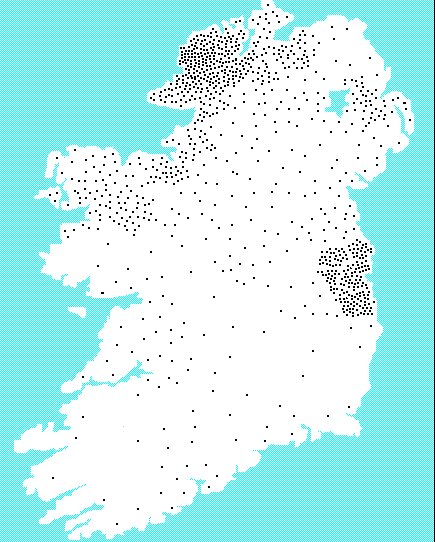
Gallagher: 5,500 families.
The boundaries of Donegal are apparent in Gallagher. Watersheds often form natural impediments to movement and watercourses sometimes do. At the opposite end of the country, the catchment area of the Barrow and Nore river system, whose watersheds often coincide with county boundaries, seems to have contained the Delaneys, and the 800 strong Bergin families. Much the same applies to the 11,300 strong Ryan name in the Golden Vale of Tipperary. A curiosity of Delaney is that the meaning of the name seems to put the origin of its families, if anywhere, in the adjacent river system of the Slaney. (Greater Dublin today stands out with these as with many names, to rival or exceed the historic area of origin of the name.)
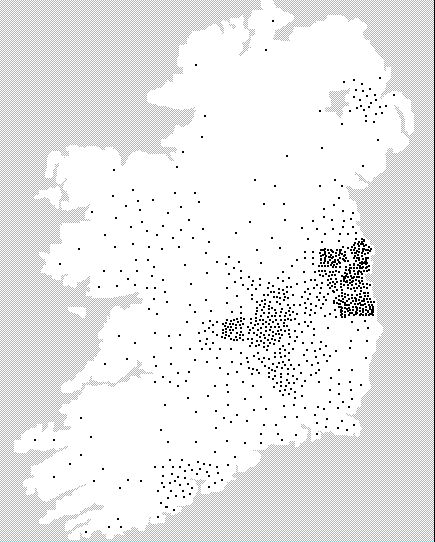
Delaney: 2,400 families.
By contrast, some names are more widespread. In such cases, typically there has been more than one location of origin. Kelly is not location specific. This may be because its root meaning (of strife, war) could apply to participants in events anywhere in the country. Kelly is the most evenly distributed name in the country.
Kelly is a name of a type which is presumably old. It recalls characteristics or virtues of an era that may be called pagan or heroic.
There are many names of this type. Some, like Kelly, have meanings which are not location specific. O'Sullivan is 'bright eyed' (probably); O'Connor and O'Neill mean champions. Some are location specific, if only in a general way. Murphy is 'sea warrior'; McNamara is 'son of the hound of the sea'; (the dog had qualities to be admired, like the bear, wolf, fox and raven. The word for dog appears in the name of the Ulster hero Cú Chulainn).
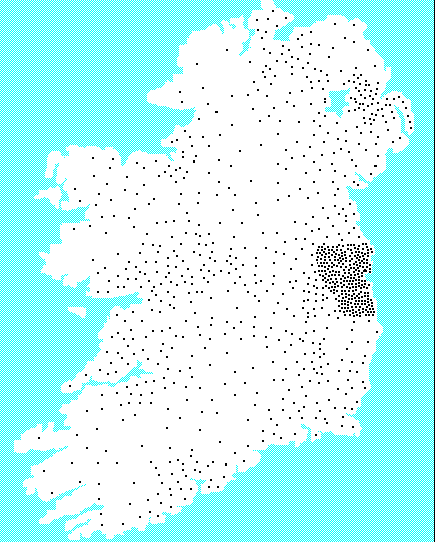
Kelly: 16,300 families.
Many of the names are just physical descriptions. What is striking about names of this type, location specific or not, is their strength in the southern half of the country and the large numbers of families that have the names. Whilst it may be said that O'Connor is western and O'Neill northern, the statistics confirm the importance of the south. O'Neill is twice as numerous relative to the rest of the population in Carlow as it is in Tyrone or Derry. An O'Connor sept of Ulster is now extinct. So names of this type tend to be southern and big.
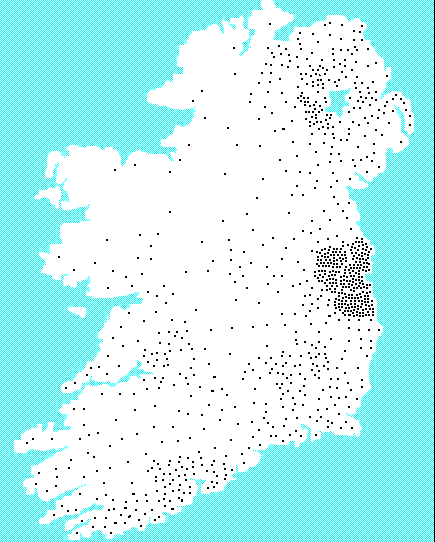
O'Neill 9,100 families.
The qualities admired in the heroic era need not necessarily be exclusively macho. The Carthy of McCarthy means 'loving'. It could be said that this name reflects a virtue more associated with Christianity, but Carthy is cognate with the British Celtic name Caractacus, a noted chieftain who fought the Romans. At 7,500 families, it is also the most numerous 'Mac' name in the country. Given its apparent antiquity and its numbers, it is unsurprising that McCarthy is a name of the south west.
By comparison there are 2,600 McDonald families in Ireland. There are also significant numbers of variants of McDonald: McDonnell, McConnell and others, not all now demonstrably connected. Yet however the clan is defined, its numbers will be far short of McCarthy. Its distribution though is wider.
McDonald may be in Ireland as a result of gallowglass movement as well as later immigrants.
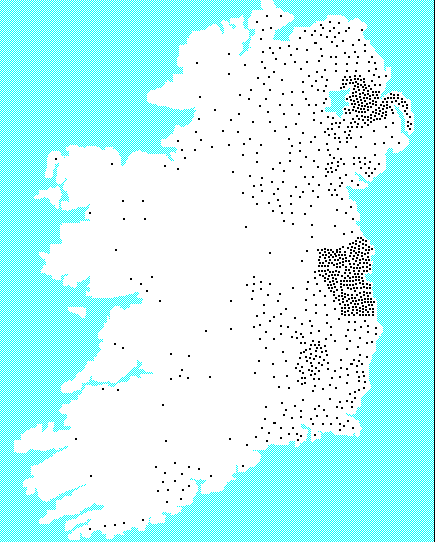
McDonald: 2,600 families
Perhaps reflecting the mixed Scots-Viking ancestry of the clan, McDonalds are found all down the east coast, an area settled by Scandinavians and having several Scandinavian placenames.
The Anglo-Norman settlement of the country brought more surnames to Ireland, most easily recognisable being those with the Fitz prefix. The most numerous surname from this settlement though was not originally a surname. It was Walsh. This is the old English singular of Welsh, being the name of unrelated Welsh retainers of the Anglo-Norman lords. Ireland now has 12,600 Walsh families, the third most numerous after Murphy and Kelly. The Walsh settlement highlights an area within which the patterns of Anglo-Norman names proper typically fit. About 2% of the families of the south coast counties have this name. Despite the early Anglo-Norman presence in Carrickfergus, these names are proportionately not well represented in the North.
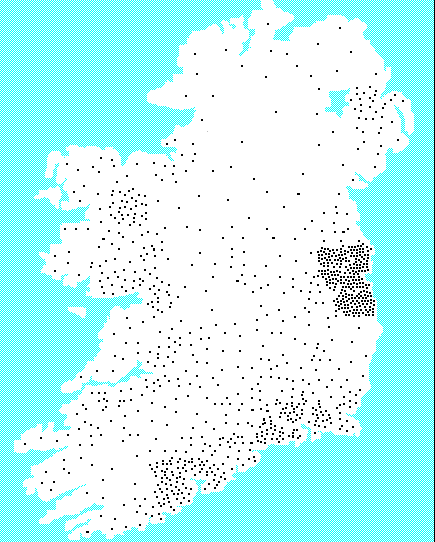
Walsh: 12,600 families.
We might expect Smith to be a widespread name - one in every village, but it is not so. In part its presence in Ireland is due to British settlement in Ulster, but in part it is a translation of the Gaelic McGowan. Historically McGowan was associated with north Leinster. Smith now is found not so much in a cluster, but in the whole country north of a line from Dublin to Donegal. The map shows a composite picture of former McGowans together with Smiths and Smyths from Britain.
Other names to do with trades or professions similarly are weak in the south. Clarke, with a self evident meaning, and McAteer/McIntyre, meaning carpenter or mason, tend to be within the area covered by Smith.
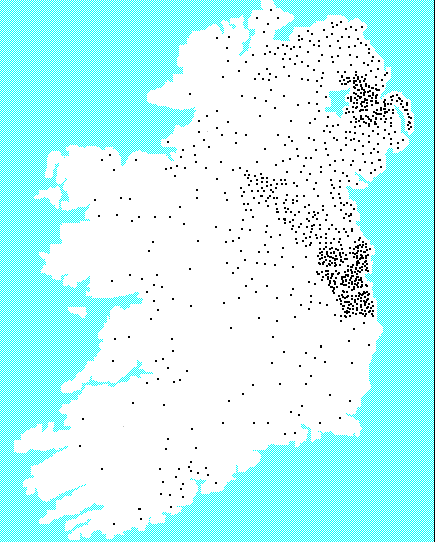
Smith, Smyth, McGowan: 11,500 families.
Moore like Smith, has origins in Ulster Gaels, and in Scottish and English migrants. It is also the modern spelling of a Norman name and so is found in the south. It is widespread, the result not so much of dispersal, but of multiple origins.
What seems to be an overall pattern is that the south of the island is strong on names from the heroic era, when virtues such as those in the meanings of Kelly or Murphy were the admired qualities. The northern half of the country has these names too, but examples there do not have the numerical strength of the south. Apart from the trade names, the north has surnames based on saints' names or on religion in other forms. This became apparent to me when I plotted McBride. This is from St Brigid, whose cult was in mid-Leinster. The families turn out to be concentrated much further to the north.
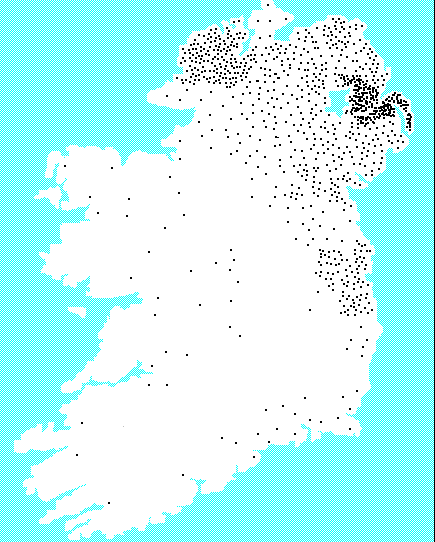
McBride: 1,600 families.
The North is where one finds Thompson, McComb and Holmes (from Thomas); McMillan/McMullen (son of the tonsured one). It is also the location of Mac names based on saints' names, whether scriptural or vernacular saints; and saints' names prefixed by 'Mul', devotee of, or 'Gil', servant of.
Another observation to be made from the overview provided by plotting surnames is the use of the prefixes 'O' and 'Mac' in Irish names. The impressions one gets from MacLysaght is that British rule was unsympathetic and so these prefixes were dropped, and that restoration has occurred since British rule has ceased.
There obviously is a dynamic to be measured in the restoration, particularly of the 'O'. Gorman is an interesting example. The name was originally McGorman. The prefix fell into disuse. A celebrity with the name erroneously assumed an 'O' and others followed suit. MacLysaght, often working with data of a century ago, found that O'Gorman was found chiefly in Clare, whilst Tipperary was plain Gorman. The distribution I find today, which cannot be illustrated on a black and white map, is that Tipperary today is also O'Gorman country. The 'O' form is evidently spreading from the south west. The present position is that 55% of the families are O'Gorman, 43% are Gorman, and only 2% are McGorman.
The immense extent of the range of use of the 'O' prefix must cast doubt on the influence the British had on this cultural feature. Generally speaking, for an individual name, there are more families with the prefix in the urban areas and the south. But the proportions vary from one name to another, even in the same regions.
The extremes are Munster names. At one end of the range, 99% of Shea families have the 'O' prefix. The Murphys, also in Munster, do not have it at all, with the possible exception of people who write their name in Gaelic. With Sullivan, 89% have the prefix.
In Leinster, 15% of Farrells have the prefix, whilst with their near neighbours the Reillys, 62% do.
In Ulster, restoration of the 'O' prefix tends to be from west to east. Some 41% of the 3,000 strong Kane families have the prefix. Those with it are mainly in the west. A paradox arises here when comparison is made with the 3,400 Keane families, the spelling variant predominant in the other three provinces. These families are further south, yet hardly any of them has the prefix.
Whilst it is not a reintroduction, another paradox arises when comparison is made with an example of the use of the 'Mac' prefix in Ulster. McCartan remains solidly with its prefix in the south east, whereas Carton, Cartin Carten and Cartan are the forms found in the north east and along the north coast of Northern Ireland.
This article set out with the intent of providing explanations of surname distributions. It would however be misleading to leave the impression that all distributions may be easily explained. O'Donovan is one of the purely descriptive names from the Old Gaelic or heroic era. It is derived from two Gaelic words: 'donn', brown, and 'dubh', black. The place of clan origin is Co. Limerick, whence the O'Donovans were forced to migrate to south west Co. Cork after the arrival of the Anglo-Normans.
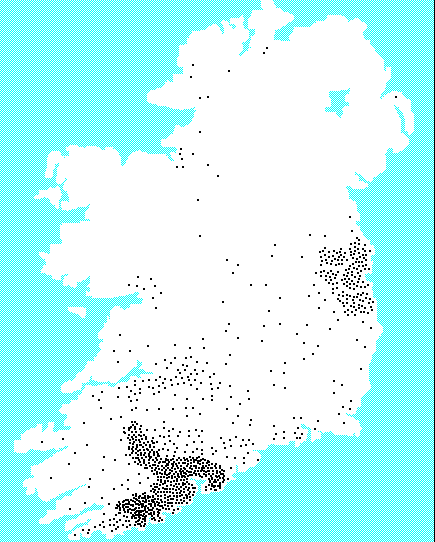
O'Donovan: 3,500 families
Donovan families are amongst those who have made a significant restoration of the prefix. Referring to 1890s' data, MacLysaght put the proportion of families with the prefix at only 2%. A century later, it is 77%.
Like many families, the O'Donovans are tightly clustered. In this case as in many others, the reasons for the particular pattern are not clear from either meaning or topography. The same pattern however is evident in the Murphy distribution, though it is more fuzzy.
These then are the impressions I have gained from mapping Irish surnames. Of necessity the treatment has to be inadequate. Each new name mapped may change the context for some of the others. Space for 200 maps cannot be provided and even if it could, there remain many more surname populations still to be mapped. Some may be mapped more completely. There may be interest to be gained from mapping all McDonald variants together insofar as that may be possible. Even alone, McDonald shows that families of settlers from the Western Isles are as dispersed as those from South Wales.
It seems that some old names are tightly clustered, as are some new ones, like Logan. Chronologically between the old and the new, some names may be widely dispersed, like Walsh and McDonald. It seems also that as one moves north, surnames have a finer grain and a greater range of types of origin, even excluding names brought from Scotland and England.
In that many names turn out to be variants of other names, the subject matter is more complex than it seems at first sight, but it does now lend itself to quantification and analysis. We are fortunate with Ireland to have the data and to have it in a form that may be broken down into small areas, which is not so eveywhere. Further, as time goes by, it will no doubt be possible to map surname distributions from the Griffith Valuation and so to make comparisons of movements between the mid 19th century and today, for any name.
Edward Kneafsey
August 1996
Mr. Kneafsey provides a service to genealogist and family researchers. He creates a surname distribution map, researchs a surname and writes a short history. The map and the history are printed on a parchment-like paper and is suitable for framing. We have a copy of Mr. Kneafsey McConville Map and History hanging in our front hall.
We receive no compensation relating to any of Mr. Kneafsey’s works or to endorse those works. Unsolicited testamonials are alway best.
You can contact Mr. Kneafsey at the URL shown below.
You can e-mail him at EdNeafsey@compuserve.com